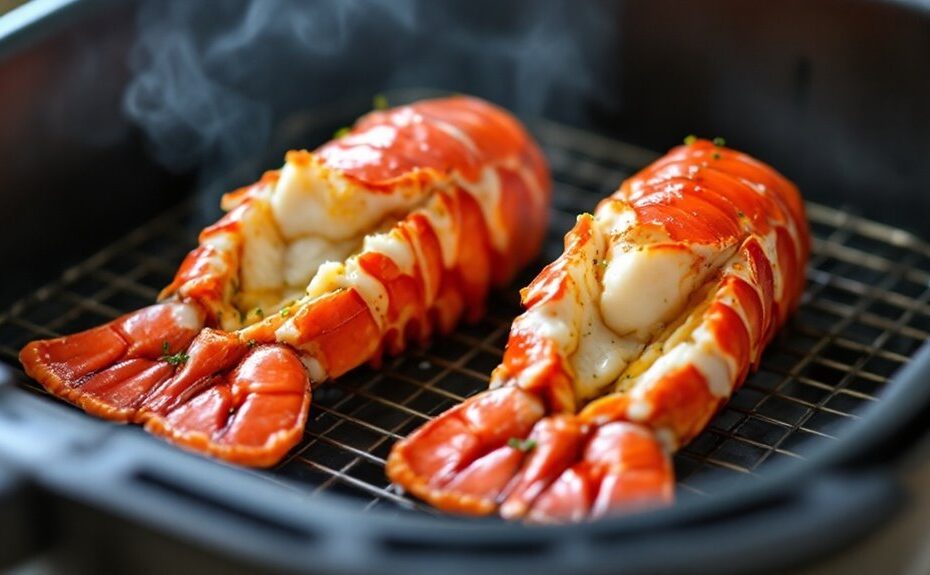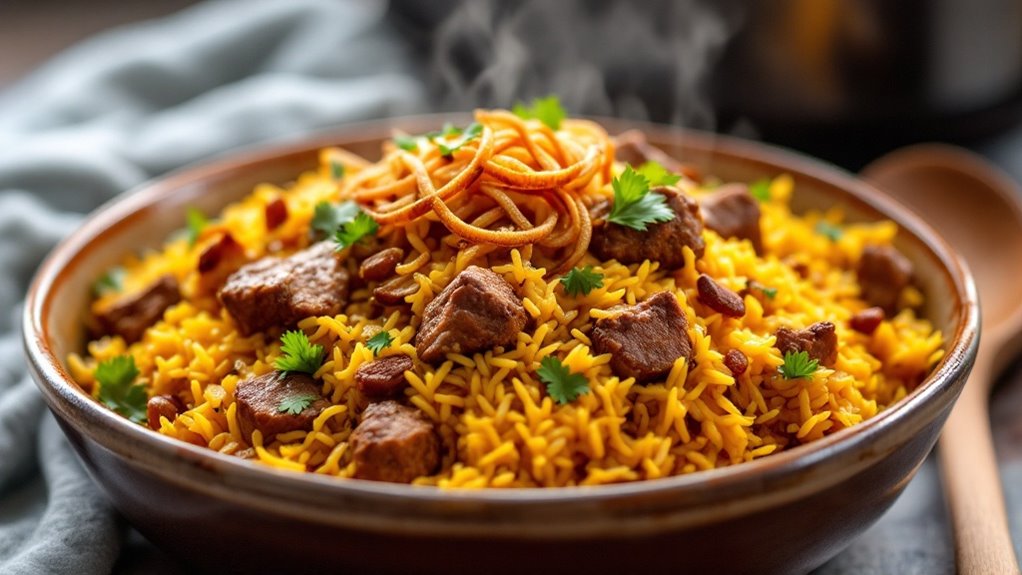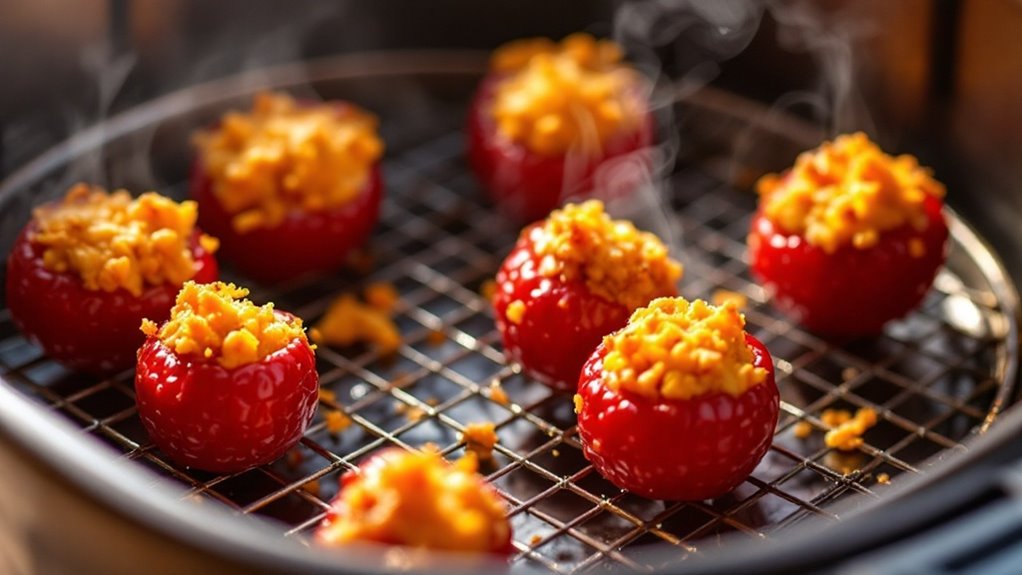You've probably never imagined that your air fryer could transform into a gourmet seafood kitchen, but lobster tails are just a few steps away from becoming your next masterpiece. By butterflying the tails and seasoning them with simple ingredients, you'll reveal a dish that's both luxurious and surprisingly easy to prepare. The air fryer's rapid heat guarantees tender, juicy results without the hassle of traditional methods. But how do you achieve that perfect balance of flavor and texture? The answer lies in a few key techniques that might just change the way you think about cooking lobster forever.
Key Takeaways
- Yes, you can make lobster tails in an air fryer for a quick, flavorful, and evenly cooked dish.
- Preheat the air fryer to 375°F and cook tails for 8–10 minutes, depending on size.
- Butterfly the tails by cutting through the shell and lifting the meat for even cooking and better presentation.
- Baste with melted butter or seasoning halfway through cooking to enhance flavor and moisture.
- Check for doneness by ensuring the meat is opaque, firm, and reaches an internal temperature of 140°F.
Choosing the Best Lobster Tails
When selecting lobster tails for your air fryer, look for ones that are firm, glossy, and free of any discoloration or strong odors. The lobster tail size matters—opt for medium to large tails (4-8 ounces) for even cooking and a satisfying texture. Smaller tails can overcook quickly, while larger ones may require adjustments to air fryer settings. Pay attention to the tail shell color; vibrant, deep greens or blues indicate freshness, while dull or faded shells suggest older stock. Avoid tails with black spots or cracks, as these can affect flavor and texture. Fresh or thawed frozen tails work well, but make sure they're fully thawed if frozen. Prioritize tails with a sweet, briny aroma, as this hints at peak flavor for your air fryer dish.
Preparing Lobster Tails for the Air Fryer
Thaw lobster tails overnight in the fridge to guarantee even cooking and a tender texture. Season generously with butter, garlic, and a pinch of paprika to enhance their natural sweetness. Carefully butterfly the tails by cutting through the top shell, then gently lift the meat to rest on top for even air frying.
Thawing Lobster Tails Properly
To guarantee your lobster tails cook evenly and retain their delicate texture, you'll need to thaw them properly before air frying. Start by choosing safe defrosting methods to preserve their quality. For a quick thaw, place the tails in a sealed plastic bag and submerge them in cold water for 30-60 minutes, changing the water every 15 minutes to maintain a safe temperature. Alternatively, transfer the tails from the freezer to the refrigerator and let them thaw overnight—this slower method secures even defrosting and minimizes texture loss. Avoid using hot water or microwaving, as these can partially cook the meat, compromising its tenderness. Once thawed, pat the tails dry with paper towels to remove excess moisture, making certain they're ready for the next step.
Seasoning for Optimal Flavor
Once your lobster tails are thawed and dried, it's time to enhance their natural sweetness with the right seasoning. Start by brushing the meat with melted butter or olive oil to help the seasoning adhere. For classic flavor, sprinkle a mix of salt, pepper, and paprika evenly over the tails. Experiment with herb combinations like parsley, thyme, and chives for a fresh, aromatic touch. If you prefer bolder flavors, try spice blends such as Cajun seasoning, Old Bay, or a mix of garlic powder, smoked paprika, and cayenne. Lightly press the seasoning into the meat to guarantee it sticks. Avoid over-seasoning, as lobster's delicate flavor should shine. Let the tails rest for 5-10 minutes to allow the flavors to meld before air frying.
Preparing Shell for Cooking
Before air frying, you'll need to prepare the lobster tails to secure even cooking and maximum flavor. Start with shell preparation methods: use kitchen shears to carefully cut through the top of the shell lengthwise, stopping just before the tail fin. Gently pull the shell apart to expose the meat, keeping it attached at the base. Lift the meat slightly and rest it on top of the shell for even air circulation. For shell cleaning techniques, rinse the tails under cold water to remove any debris, then pat them dry with paper towels. This makes certain the seasoning adheres well and prevents steaming during cooking. Properly prepped shells not only enhance presentation but also help the lobster cook evenly, locking in its natural sweetness and tender texture.
Seasoning Tips for Perfect Flavor
Choose fresh herbs like parsley, chives, or tarragon to enhance the lobster's natural sweetness without overpowering it. Balance spices wisely by using a light hand with paprika, cayenne, or garlic powder to add depth without masking the delicate flavor. Always finish with a touch of high-quality butter or olive oil to amplify the seasoning and create a rich, cohesive taste.
Choose Fresh Herbs
To elevate the flavor of your air fryer lobster tails, fresh herbs are essential for adding brightness and depth. Start with a fresh selection of herbs like parsley, dill, chives, or tarragon, as their vibrant flavors complement the delicate sweetness of lobster. For herb pairing, combine parsley and chives for a classic, clean finish, or use dill and tarragon for a slightly anise-like complexity. Chop the herbs finely to release their oils and sprinkle them over the lobster tails after cooking to preserve their freshness. Avoid dried herbs, as they lack the aromatic punch needed for this dish. Fresh herbs not only enhance the taste but also add a pop of color, making your lobster tails visually appealing and restaurant-quality.
Balance Spices Wisely
While lobster tails are naturally rich and flavorful, balancing spices is key to enhancing their taste without overpowering their delicate profile. Start with a light hand when seasoning, as lobster's sweetness can be easily masked. Use spice combinations like paprika, garlic powder, and a pinch of cayenne for a subtle kick. Pair these with fresh herbs like thyme or parsley to maintain a harmonious flavor balance. Avoid heavy spices like cumin or chili powder, which can dominate. A touch of lemon zest or a sprinkle of Old Bay seasoning can elevate the natural brininess. Always taste as you go, adjusting gradually to guarantee the spices complement rather than compete. Remember, less is often more when aiming for a perfectly seasoned lobster tail.
Preheating Your Air Fryer Correctly
Before cooking lobster tails in your air fryer, it's essential to preheat the appliance to secure uniform cooking and the best possible texture. Set your air fryer to the recommended preheat settings, typically between 350°F and 400°F, depending on your model. Allow it to heat for 3-5 minutes to confirm temperature accuracy, which is key to achieving perfectly cooked lobster tails. Preheating prevents undercooking or uneven browning, securing the meat stays tender and succulent. Always check your air fryer's manual for specific preheating instructions, as models vary. Avoid skipping this step—cold air fryers can lead to soggy or overcooked results. Proper preheating locks in the lobster's natural sweetness and enhances its delicate flavor, setting the stage for a restaurant-quality dish.
Cooking Time and Temperature Guidelines
Once your air fryer is preheated, set the temperature to 375°F for cooking lobster tails, as this guarantees the meat cooks evenly without drying out. Cook for 8–10 minutes, depending on the size of the tails. Smaller tails (4–6 oz) typically take 8 minutes, while larger ones (8–10 oz) may need up to 10 minutes. For temperature adjustments, reduce to 350°F if your air fryer runs hot or increase to 400°F for a crispier finish. Cooking variations include basting the tails with melted butter or garlic herb sauce halfway through for added flavor. Always check for doneness—the meat should be opaque and firm, not translucent. Avoid overcooking, as it can toughen the lobster. Adjust timing slightly based on your air fryer model and desired texture.
How to Butterfly Lobster Tails
To butterfly lobster tails, start by placing the tail shell-side down on a cutting board. Using sharp kitchen shears, cut lengthwise through the top shell, stopping just before the tail fin. Gently spread the shell open to expose the meat, then carefully lift it out of the shell, keeping it attached at the base. Press the shell flat to fully reveal the meat. For the butterfly technique, make a shallow cut down the center of the meat, stopping before the tail fin, and gently pull the two halves apart to create a fan-like shape. This tail preparation guarantees even cooking and maximizes flavor absorption. Rinse the tail under cold water to remove any shell fragments, then pat dry with paper towels before seasoning or cooking.
Adding Butter for Extra Richness
After butterflying the lobster tails, you'll want to enhance their richness by incorporating butter. Melt unsalted butter and brush it generously over the exposed meat, guaranteeing it seeps into the crevices for maximum flavor. For a deeper taste, mix in minced garlic, lemon zest, or fresh herbs like parsley or chives. If you prefer butter alternatives, consider using ghee, olive oil, or clarified butter, which offer similar richness without burning at high temperatures. These options also add subtle flavor nuances that complement the lobster's natural sweetness. Avoid over-saturating the meat; a light, even coating is key to enhancing richness without overpowering the delicate texture. This step guarantees your lobster tails emerge from the air fryer succulent, flavorful, and perfectly indulgent.
Checking for Doneness Without Overcooking
With the lobster tails buttered and ready, the next step is ensuring they're cooked to perfection. Start by checking the internal temperature with a meat thermometer; it should read 140°F (60°C) for tender, juicy meat. Avoid overcooking, as lobster can become rubbery. Look for visual cues: the meat should turn opaque and white, with a slight translucency at the center. The shells will turn bright red, and the flesh should pull away slightly from the edges. If the tails curl excessively, they're likely overdone. Air fry in short intervals, checking every 2-3 minutes after the initial 8 minutes. Remember, residual heat will continue cooking the lobster after removal, so err on the side of slightly underdone. Perfectly cooked lobster tails are succulent, flavorful, and worth the precision.
Serving Suggestions for Air Fryer Lobster Tails
Once your lobster tails are perfectly cooked, serve them immediately to preserve their tender texture and rich flavor. Pair them with classic side dishes like garlic butter asparagus, creamy mashed potatoes, or a fresh citrus salad to balance the richness. For a lighter option, try steamed broccoli or a quinoa pilaf. Enhance the experience with a drizzle of melted butter or a squeeze of lemon. When it comes to wine pairings, opt for a crisp Chardonnay or a dry Sauvignon Blanc to complement the lobster's sweetness. If you prefer red, a light Pinot Noir works well. Garnish with fresh herbs like parsley or chives for a pop of color and flavor. Serve on a warm platter to keep the lobster tails at their best.
Cleaning and Maintaining Your Air Fryer After Use
After cooking, unplug your air fryer and let it cool completely before wiping the basket and interior with a damp cloth or sponge to remove any grease or residue. Regularly check the heating element for buildup and clean it gently with a soft brush to maintain peak performance. Store your air fryer in a dry, dust-free area to preserve its functionality and guarantee it's ready for your next flavorful creation.
Proper Cleaning Techniques
To keep your air fryer performing at its best and guarantee your lobster tails taste as fresh as possible, you'll want to clean it thoroughly after each use. Start by unplugging the appliance and letting it cool completely. Remove the basket and tray, then wash them with warm, soapy water, scrubbing gently to remove any grease or food residue. For stubborn bits, use a non-abrasive sponge or brush. Wipe down the interior and exterior with a damp cloth, avoiding harsh chemicals that could damage the surface. Follow food safety tips by ensuring all parts are dry before reassembling. Adopt hygiene best practices by cleaning the air fryer after every use to prevent cross-contamination and maintain peak flavor for your next batch of lobster tails.
Regular Maintenance Tips
While regular cleaning is essential, maintaining your air fryer's performance also involves consistent upkeep. After each use, remove and clean the basket thoroughly to prevent grease buildup, which can affect flavor and efficiency. Use warm, soapy water and a non-abrasive sponge to avoid damaging the non-stick coating. Check the air fryer's filter regularly; replace it if it's clogged or worn out to guarantee proper airflow and prevent odors. Wipe down the exterior with a damp cloth to remove any residue or fingerprints. Inspect the heating element for debris and clean it gently with a soft brush. Store your air fryer in a dry, cool place to avoid moisture damage. Consistent maintenance secures your air fryer delivers perfectly cooked lobster tails and other dishes every time.
Disclosure: As an Amazon Associate, I earn from qualifying purchases.



